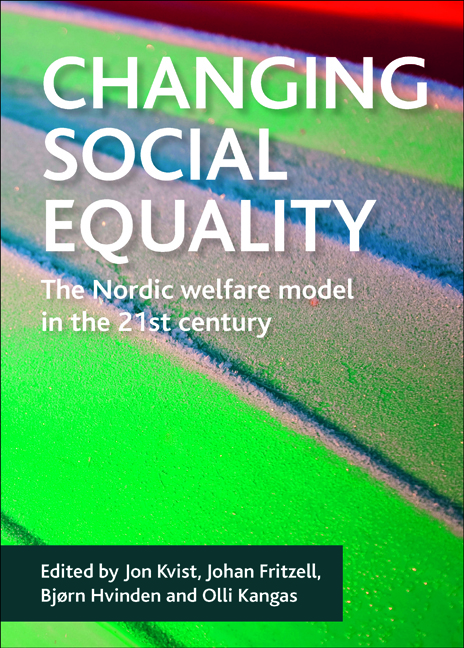Book contents
- Frontmatter
- Contents
- List of tables and figures
- Notes on contributors
- Acknowledgements
- one Changing social inequality and the Nordic welfare model
- two Anti-immigration attitudes, support for redistribution and party choice in Europe
- three Do we all (dis)like the same welfare state? Configurations of public support for the welfare state in comparative perspective
- four Eroding minimum income protection in the Nordic countries? Reassessing the Nordic model of social assistance
- five Equality in the social service state: Nordic childcare models in comparative perspective
- six Welfare state institutions, unemployment and poverty: comparative analysis of unemployment benefits and labour market participation in 15 European Union countries
- seven Social inequalities in health: the Nordic welfare state in a comparative context
- eight Income inequality and poverty: do the Nordic countries still constitute a family of their own?
- nine Is immigration challenging the economic sustainability of the Nordic welfare model?
- ten Nordic responses to rising inequalities: still pursuing a distinct path or joining the rest?
- Index
eight - Income inequality and poverty: do the Nordic countries still constitute a family of their own?
Published online by Cambridge University Press: 01 September 2022
- Frontmatter
- Contents
- List of tables and figures
- Notes on contributors
- Acknowledgements
- one Changing social inequality and the Nordic welfare model
- two Anti-immigration attitudes, support for redistribution and party choice in Europe
- three Do we all (dis)like the same welfare state? Configurations of public support for the welfare state in comparative perspective
- four Eroding minimum income protection in the Nordic countries? Reassessing the Nordic model of social assistance
- five Equality in the social service state: Nordic childcare models in comparative perspective
- six Welfare state institutions, unemployment and poverty: comparative analysis of unemployment benefits and labour market participation in 15 European Union countries
- seven Social inequalities in health: the Nordic welfare state in a comparative context
- eight Income inequality and poverty: do the Nordic countries still constitute a family of their own?
- nine Is immigration challenging the economic sustainability of the Nordic welfare model?
- ten Nordic responses to rising inequalities: still pursuing a distinct path or joining the rest?
- Index
Summary
Introduction
The comparatively low degrees of income inequalities and relative poverty rates have long been a salient feature of the Nordic countries. Low inequality and low poverty rates are commonly viewed as key ingredients of what constitutes the Nordic welfare model (see, for example, Kautto et al, 1999), with strong influences from institutional characteristics and welfare state redistribution systems (see, for example, Brandolini and Smeeding, 2007; Bäckman, 2009; Fritzell and Ritakallio, 2010). A fundamental dimension of these social schemes – and of the Nordic model in general – is universalism (Kildal and Kuhnle, 2005). No doubt, there is abundant evidence that the Nordic countries have been at the top of the equality league and that they actually form a family of their own when it comes to poverty and income inequality. As one of us concluded in an earlier study of income inequality in a number of European countries, analysing whether the Nordic countries were becoming more like other European countries: ‘Yes, the Nordic countries … still have a low degree of inequality in the distribution of income and No, we find no support for a convergence’ (Fritzell, 2001, p 39).
Moreover, more recent publications by supranational organisations suggest that the Nordic countries are among those with the lowest income inequality and relatively low poverty rates (OECD, 2008; Eurostat, 2010). The thorough OECD (Organisation for Economic Co-operation and Development) report Growing unequal (2008) concludes that the countries with the most compressed income distributions are Denmark and Sweden, placing Finland, Iceland and Norway in a group of European countries with similar degrees of income inequality. Most national Nordic reports and official statistics have, however, shown that income inequality has widened. Thus the fundamental question in this chapter is whether the Nordic countries are different in terms of income inequality and poverty. In other words, do they still constitute a family of their own?
Welfare regimes and poverty and inequality
The concept of welfare regimes provides the broad framework for this volume. Given the three types of welfare capitalism – Liberal, Conservative-Corporatist and Social Democratic (Esping-Andersen, 1990) – we see that basic principles differ among regimes. Although the examination of welfare state typologies can certainly be seen as obsessive (Abrahamson, 1999), we nonetheless must understand welfare state variation not as a one-dimensional element but as differences in kind (and not merely degrees) (Titmuss, 1974).
- Type
- Chapter
- Information
- Changing Social EqualityThe Nordic Welfare Model in the 21st Century, pp. 165 - 186Publisher: Bristol University PressPrint publication year: 2011
- 1
- Cited by



